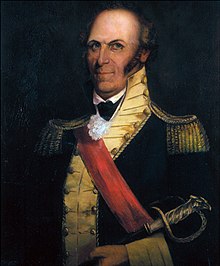
Little Turtle was a Sagamore (chief) of the Miami people, who became one of the most famous Native American military leaders. Historian Wiley Sword calls him "perhaps the most capable Indian leader then in the Northwest Territory," although he later signed several treaties ceding land, which caused him to lose his leader status during the battles which became a prelude to the War of 1812. In the 1790s, Mihšihkinaahkwa led a confederation of native warriors to several major victories against U.S. forces in the Northwest Indian Wars, sometimes called "Little Turtle's War", particularly St. Clair's defeat in 1791, wherein the confederation defeated General Arthur St. Clair, who lost 900 men in the most decisive loss by the U.S. Army against Native American forces.

The Miami are a Native American nation originally speaking one of the Algonquian languages. Among the peoples known as the Great Lakes tribes, they occupied territory that is now identified as north-central Indiana, southwest Michigan, and western Ohio. The Miami were historically made up of several prominent subgroups, including the Piankeshaw, Wea, Pepikokia, Kilatika, Mengakonkia, and Atchakangouen. In modern times, Miami is used more specifically to refer to the Atchakangouen. By 1846, most of the Miami had been forcefully displaced to Indian Territory. The Miami Tribe of Oklahoma are the federally recognized tribe of Miami Indians in the United States. The Miami Nation of Indiana, a nonprofit organization of self-identified descendants of Miamis who were exempted from removal, have unsuccessfully sought separate recognition.

Josiah Harmar was an officer in the United States Army during the American Revolutionary War and the Northwest Indian War. He was the senior officer in the Army for six years and seven months.

The Battle of Fallen Timbers was the final battle of the Northwest Indian War, a struggle between Native American tribes affiliated with the Northwestern Confederacy and their British allies, against the nascent United States for control of the Northwest Territory. The battle took place amid trees toppled by a tornado near the Maumee River in northwestern Ohio at the site of the present-day city of Maumee, Ohio.

The Treaty of Greenville, also known to Americans as the Treaty with the Wyandots, etc., but formally titled A treaty of peace between the United States of America, and the tribes of Indians called the Wyandots, Delawares, Shawanees, Ottawas, Chippewas, Pattawatimas, Miamis, Eel Rivers, Weas, Kickapoos, Piankeshaws, and Kaskaskias was a 1795 treaty between the United States and indigenous nations of the Northwest Territory, including the Wyandot and Delaware peoples, that redefined the boundary between indigenous peoples' lands and territory for European American community settlement.
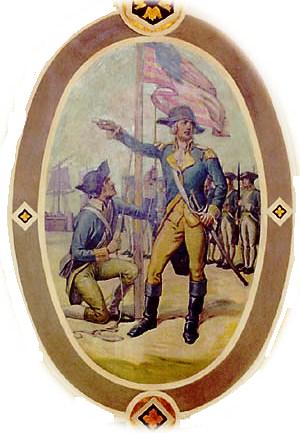
Jean-François Hamtramck (1756–1803) was a Canadian who served as an officer in the US Army during the American Revolutionary War and the Northwest Indian War. In the Revolution, he participated in the Invasion of Quebec, the Sullivan Expedition, and the Siege of Yorktown. In the history of United States expansion into the Northwest Territory, Hamtramck is connected to 18th century forts at modern Midwest cities such as Steubenville, Vincennes, Fort Wayne, and Detroit. The city of Hamtramck, Michigan is named for him.

Fort Ouiatenon, built in 1717, was the first fortified European settlement in what is now Indiana, United States. It was a palisade stockade with log blockhouse used as a French trading post on the Wabash River located approximately three miles southwest of modern-day West Lafayette. The name 'Ouiatenon' is a French rendering of the name in the Wea language, waayaahtanonki, meaning 'place of the whirlpool'. It was one of three French forts built during the 18th century in what was then New France, later the Northwest Territory and today the state of Indiana, the other two being Fort Miami and Fort Vincennes. A substantial French settlement grew up around the fort in the mid-18th century. It was ceded to the British and abandoned after the French and Indian war. Later, it passed into Indian hands and was destroyed in 1791 by American militia during the Northwest Indian War. It was never a U.S. fort. The original site was rediscovered in the 1960s; the archaeological site was listed on the National Register of Historic Places in 1970, and was designated a National Historic Landmark in 2021.
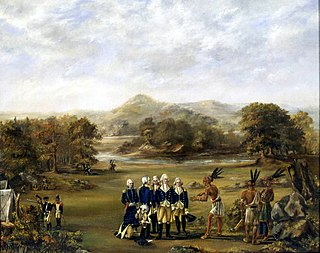
The Northwest Indian War (1785–1795), also known by other names, was an armed conflict for control of the Northwest Territory fought between the United States and a united group of Native American nations known today as the Northwestern Confederacy. The United States Army considers it the first of the American Indian Wars.
John Hardin was an American soldier, scout, and frontiersman. As a young man, he fought in Lord Dunmore's War, in which he was wounded, and gained a reputation as a marksman and "Indian killer." He served in the Continental Army during the American Revolutionary War, where he played a noteworthy role in the American victory at Saratoga in 1777. After the war, he moved to Kentucky, where he fought against Native Americans in the Northwest Indian War. In 1790, he led a detachment of Kentucky militia in a disastrous defeat known as "Hardin's Defeat." In 1792, he was killed while serving as an emissary to the Natives in the Northwest Territory.
Kekionga, also known as Kiskakon or Pacan's Village, was the capital of the Miami tribe. It was located at the confluence of the Saint Joseph and Saint Marys rivers to form the Maumee River on the western edge of the Great Black Swamp in present-day Indiana. Over their respective decades of influence from colonial times to after the American Revolution, French and Indian Wars, and the Northwest Indian Wars, the French, British and Americans all established trading posts and forts at the large village, originally known as Fort Miami, due to its key location on the portage connecting Lake Erie to the Wabash and Mississippi rivers. The European-American town of Fort Wayne, Indiana started as a settlement around the American Fort Wayne stockade after the War of 1812.

William Wells, also known as Apekonit, was the son-in-law of Chief Little Turtle of the Miami. He fought for the Miami in the Northwest Indian War. During the course of that war, he became a United States Army officer, and also served in the War of 1812.
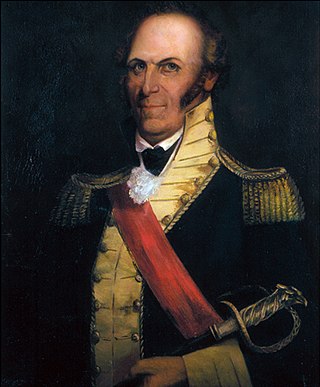
Charles Scott was an American military officer and politician who served as the governor of Kentucky from 1808 to 1812. Orphaned in his teens, Scott enlisted in the Virginia Regiment in October 1755 and served as a scout and escort during the French and Indian War. He quickly rose through the ranks to become a captain. After the war, he married and engaged in agricultural pursuits on land left to him by his father, but he returned to active military service in 1775 as the American Revolution began to grow in intensity. In August 1776, he was promoted to colonel and given command of the 5th Virginia Regiment. The 5th Virginia joined George Washington in New Jersey later that year, serving with him for the duration of the Philadelphia campaign. Scott commanded Washington's light infantry, and by late 1778 was also serving as his chief of intelligence. Furloughed at the end of the Philadelphia campaign, Scott returned to active service in March 1779 and was ordered to South Carolina to assist General Benjamin Lincoln in the southern theater. He arrived in Charleston, South Carolina, just as Henry Clinton had begun his siege of the city. Scott was taken as a prisoner of war when Charleston surrendered. Paroled in March 1781 and exchanged for Lord Rawdon in July 1782, Scott managed to complete a few recruiting assignments before the war ended.
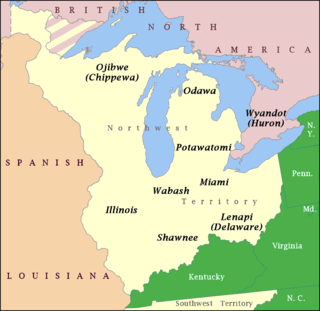
The Northwestern Confederacy, or Northwestern Indian Confederacy, was a loose confederacy of Native Americans in the Great Lakes region of the United States created after the American Revolutionary War. Formally, the confederacy referred to itself as the United Indian Nations, at their Confederate Council. It was known infrequently as the Miami Confederacy since many contemporaneous federal officials overestimated the influence and numerical strength of the Miami tribes based on the size of their principal city, Kekionga.
Ouiatenon was a dwelling place of members of the Wea tribe of Native Americans. The name Ouiatenon, also variously given as Ouiatanon, Oujatanon, Ouiatano or other similar forms, is a French rendering of a term from the Wea dialect of the Miami-Illinois language which means "place of the people of the whirlpool", an ethnonym for the Wea. Ouiatenon can be said to refer generally to any settlement of Wea or to their tribal lands as a whole, though the name is most frequently used to refer to a group of extinct settlements situated together along the Wabash River in what is now western Tippecanoe County, Indiana.

Pacanne was a leading Miami chief during the late 18th and early 19th centuries. Son of The Turtle (Aquenackqua), he was the brother of Tacumwah, who was the mother of Chief Jean Baptiste Richardville. Their family owned and controlled the Long Portage, an 8-mile strip of land between the Maumee and Wabash Rivers used by traders travelling between Canada and Louisiana. As such, they were one of the most influential families of Kekionga.

The Battle of Kenapacomaqua, also called the Battle of Old Town, was a raid in 1791 by United States forces under the command of Lieutenant Colonel James Wilkinson on the Miami (Wea) town of Kenapacomaqua on the Eel River, approximately six miles upstream from present-day Logansport, Indiana.

The Harmar campaign was an attempt by the United States Army to subdue confederated Native Americans nations in the Northwest Territory that were seen as hostile in Autumn 1790. The campaign was led by General Josiah Harmar and is considered a significant campaign of the Northwest Indian War. The campaign ended with a series of battles on 19–22 October 1790 near the Fort Miami and Miami village of Kekionga. These were all overwhelming victories for the Native Americans and are sometimes collectively referred to as Harmar's Defeat.

St. Clair's defeat, also known as the Battle of the Wabash, the Battle of Wabash River or the Battle of a Thousand Slain, was a battle fought on 4 November 1791 in the Northwest Territory of the United States. The U.S. Army faced the Western Confederacy of Native Americans, as part of the Northwest Indian War. It was "the most decisive defeat in the history of the American military" and its largest defeat ever by Native Americans.
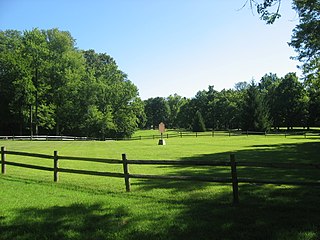
Fort St. Clair was a fort built during the Northwest Indian War near the modern town of Eaton, Preble County, Ohio. The site of the fort was listed on the National Register of Historic Places in 1970.

During the onset of the Northwest Indian War (1786–1795), there were numerous skirmishes around Vincennes in 1786 between American settlers and Native Americans near Vincennes, a frontier town on the Wabash River. American pioneers had been pouring into the area after the American Revolutionary War, creating tensions with the Native inhabitants of the region.
